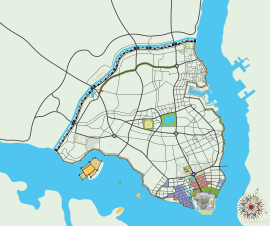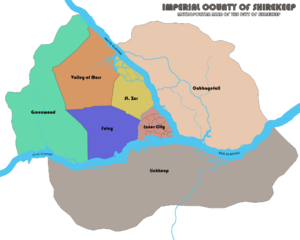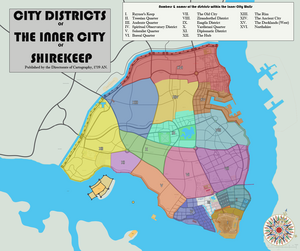Shirekeep
| Shirekeep Sxirosikx / Imperial County of Shirekeep | |||

| |||
| Top to bottom: Palace of Zirandorthel, view on Fort Tempus (left), Raynor Mausoleum (right), Wall of Reynardine, Kaiser's Boulevard. | |||
| |||
| Motto: | |||
| Anthem: | |||

| |||
| Map versions | |||
| Official language(s) | Præta (official) Babkhi, Elw, Istvanistani, Jingdaoese (tolerated) | ||
| Demonym | Shirekeeper | ||
| - Adjective | Shirekeepian | ||
| Government | Capital City | ||
| Prefect of Shirekeep | Mira III Octavius-Aryani | ||
| Legislature | Council of Provosts | ||
| Establishment | Around 100 AN | ||
| Area | Bailiwicks: Cabbagefall, Foley, Inner City, Lichkeep, Greenwood, Saint Zor, Valley of Mors Inner City: 16 Districts | ||
| Population | 40,082,533 (1674) | ||
| Currency | Erb | ||
| Abbreviation | |||
| Time zone(s) | |||
| Patron | Raynor-who-slaughtered-Rrakanychan | ||
| Animal | |||
| Drink | |||


Shirekeep is the capital and chief city of Shireroth. It's metropolis is officially known as the Imperial County of Shirekeep. When people - especially tourists - refer to Shirekeep, they generally refer to the most ancient and central parts of the city: the Inner City, due to the presence of several of its most important and famous monuments. However, the Inner City is merely a small fraction of the City (which is often referred to as Imperial Country, or Greater Shirekeep). The population of the Imperial County (1674) is 40,082,533 persons, making Shirekeep one of the world's most populous cities. The city has a high population density. It has had a reputation of being crowded, dirty, and polluted.
It is the political, economic, cultural, and religious center of Shireroth. It holds the seat of the Imperial Government, and its historic Raynor's Keep serves as the official residence of the Kaiser. The city is also home to the Legislature and the Imperial Judex. It is the site of the Temple of Mors, one of the most important religious shrine in the nation.
Shirekeep is home to numerous museums, art galleries, theaters, and libraries. It is known for its vibrant nightlife - as long as one does not leave the Inner City-, world-class shopping - the Imeritus Pleasure District -, and numerous festivals. The city is also home to some of Shireroth's most famous landmarks, such as the Esagila of Raynor, the Shirewikian Imperial Library, and Malarborty Park.
Several voices call for the Raynor's Keep of Shirekeep to become a Shirerithian Heritage Site as a whole. It is also home to numerous historical and cultural sites, including the Golden, Silver and Iron Gates, the Inner Keep, the Great Armory, and the Astronomy Tower. The city is also home to several universities, including the prestigious Metzler University.
Shirekeep is connected to the rest of Shireroth by a network of roads, railways, and an international airport. It is also served by a number of ferry services and a tram and bus system.
History
According to the oldest records available, Shirekeep was founded when Raynor I established his stronghold between the fork of the Blue Elwynn and the White Elwynn in the mid-1st century. The city's mythological foundation went hand in hand with the proclamation of the Duchy of Brookshire and the areas of Goldshire recently conquered by the young Duke as an empire. He himself ascended the throne as the first Kaiser of Shireroth. His most loyal vassals and generals received some say in a Landsraad, which led Raynor's successors to refer to the realm as an Imperial Republic, despite the lack of any real semblance to a res publica.

With the conquest and pacification of the area between the Blue and White Elwynn, several farming communities emerged. Thus, the wards of Northshire, Old City, Ancient City (originally Raynor's Village) and Raynor's Keep saw the light of day as separate villages and hamlets.
The town of Northshire would play a vital role as a springboard for the conquests of the tribes in the north. So important itself that it grew into a central trading place. Its prosperity increased to such an extent that wooden defenses appeared around the village. For a time it itself acted as the capital of the newly conquered territories. This role eventually gradually lost as a series of Kaisers successfully dealt with the rebelliousness of the Elfinshi and Elws. At about the same time, a group of monks founded a temple to the south-west of Northshire in honor of the god Mors. Raynor's Village grew around the temple, which became a place of pilgrimage for the many fallen in the wars. As Northshire grew into a commercial trading town, Raynor's Village and its temple grew richer thanks to the many pilgrimages made from Goldshire and Brookshire.
However, the military campaigns were not always decisive in ensuring peace in the areas that now comprise the Inner City. It happened that both Northshire and Raynor's Village were raided several times. Nevertheless, the two communities managed to serve as a defensive wall and to protect the agricultural lands behind against the danger. By the reign of Kaiser Leto I (during the 5th century) had grown to such an extent that they were all absorbed into the conurbation of the fledgling Shirekeep.
The city continued to grow over the centuries. It is generally accepted that the Inner City reached its current size during the reign of Kaiser Los II (late 15th century). The city walls built by Los II following the War of the Wylthean Succession formed the foundations of Kaiser Reynardine I's fortified city walls, the famed Walls of Reynardine, which still stand today and are the City's most visible division between the city center and the rest of the metropolis.
The city would weather the storm of the Kalirion Fracture with minimal destruction, as the separatist "Vulture States" were mostly content to secure their breakaway provinces rather than honour tradition by laying siege to the capital. The long peace which followed, between 1672 AN and 1724 AN, drew to a close after Operation Jagdbeute, an unsuccessful attempt by the Raspur Pact to recover military articles, stores, and personnel from Shirerithian territory ahead of the Imperial Republic's widely anticipated withdrawal from the Pact. This conflict led to a rupture in the, by then mostly nominal, alliance between Shireroth and the Benacian Union. The ensuing Shiro-Benacian Cold War would see the frontier between the Imperial County and Alalehzamin and the Sovereign Confederation sealed by order of the Steward. The response of the High Presidium of the Benacian Union and Benacia Command would see Shirekeep's riverine trade and air traffic strangled by a counter-blockade begun in 1730 AN.
As such, Shirekeep would enter the fourth decade of the eighteenth century after Norton in a strange limbo, trapped in a false peace that would forever be threatening to tip over into overt total war at the slightest provocation.
Administration
Bailiwicks and City Districts


The city is divided into seven bailiwicks. These all belong to the metropolis of Shirekeep. A majority of the population does not live in the famous Inner City, but in the suburbs of the city. A series of forts have been placed in the bailiwicks around the Inner City for protection. The area that is part of Shirekeep today is (much) more extensive than the historic city center within the Walls of Reynardine. The so-called Inner City may be home to most of the city's most famous monuments and most important institutions, but a majority of the inhabitants live in the Bailiwicks outside the walls.
Because of its special character, the Inner City is divided into City Districts whose boundaries are roughly based on community or village boundaries dating back as far as the time of Kaiser Raynor I.
The bailiwicks are as follows:
The Inner City forms one bailiwick, which in turn is divided into 16 different districts. These all received numbers to which are referred in official documents:
I. Raynor's Keep
II. Treesian Quarter
III. Audente Quarter
IV. Spiritual Observatory District
V. Soloralist Quarter
VI. Boreal Quarter
VII. The Old City
VIII. Zirandorthel District
IX. Esagila District
X. Yardistani Quarter
XI. Diplomatic District
XII. The Hub
XIII. The Rim
XIV. The Ancient City
XV. The Docklands (West)
XVI. Northshire
Council of Provosts
Shirekeep is politically divided into Quarters, who each elect a Quarter Council to manage that particular area. This body elects one Provost to chair the Council for a 3 year period. The Provosts sit in the Council of Provosts, which constitutes Shirekeep's central elected body. However, the power of the city remains in the hands of the Prefect, who is appointed directly by the Kaiser.
Prefect
The Prefect of Shirekeep (before 1577 AN called the Lord Mayor) is the, by the Kaiser appointed, ruler of the Imperial Capital and County of the same name.
The Prefectoral Palace was located the Boreal Quarter of Shirekeep and served as the administrative centre of the Prefect and his administration before it was burnt down during the Year of the Four Kaisers.
During the administration of Titus Morvayne the Prefect was advised and assisted by a Council of Provosts, an elected council divided along party political lines. The Council was however suppressed with the downfall of Titus.
List of Prefects
| Portrait | Name | Reign | Comment |
|---|---|---|---|
| File:Senechal Jon'Kur I portrait.png | Jonas Win'Eth | 1577–1591 | First to hold the title of Prefect instead of Lord Mayor |
| File:Kai Jackson.jpg | Kai Jackson | 1591–1594, 1594–1610 | Hottest Prefect in recorded history, served two non-consecutive terms |
 |
Shyriath Letifer Farstrider of Mortis | 1610–1622 | |
 |
Audun Joel Ayreon-Kalirion | 1642–1644 | Marquess of Shirekeep |
 |
Mira II Octavius-Aryani | 1645–1663 | Also Steward (1657–1663) and Countess of Shirekeep, 1661-1663. Assassinated in the Steward's Tower of Raynor's Keep |
| File:Titus Morvayne.png | Titus Morvayne | 1664–1672 | First Prefect taken from within Shirekeep's government |
 |
Mira III Octavius-Aryani | 1672–1737 | Countess of Shirekeep 1663 –. "De facto" Prefect since the deposition of Titus Morvayne in 1672. |
| Erasmo Laegel | 1737- | Elected by popular (mob) demand during the Mango Anarchy. Established the Revolutionary Committee of Shirekeep. |
Demographics
Data from the 1674 Shireroth census.
| Division | Total population | Citizens | Denizens | Loyal subjects | Community servants | Protected persons |
|---|---|---|---|---|---|---|
| The Inner City | 576,109 | 36,710 | 345,990 | 110,884 | 72,037 | 10,488 |
| Cabbagefall | 14,620,574 | 310,884 | 11,458,830 | 2,037,992 | 805,964 | 6,904 |
| Lichkeep | 13,412,846 | 359,093 | 10,108,262 | 2,037,927 | 903,882 | 3,682 |
| Northshire South | 11,473,004 | 190,884 | 7,955,030 | 2,088,933 | 1,234,048 | 4,109 |
| Division | Citizens | Denizens | Loyal subjects | Community servants | Protected persons |
|---|---|---|---|---|---|
| The Inner City | 6% | 60% | 19% | 13% | 2% |
| Cabbagefall | 2% | 78% | 14% | 6% | 0% |
| Lichkeep | 3% | 75% | 15% | 7% | 0% |
| Northshire South | 2% | 69% | 18% | 11% | 0% |
Public Health

The insanitary conditions of Shirekeep and its environs, including the Underkeep, long submerged in backed up effluent, have become infamous the world over and gave rise to a myriad of disease. The suspicion has been for many years that a great mortality has been kept at bay in the city only by the continual warring of the bacterial microbes as to which should give rise to the next exterminating pestilence.
A Shirekeeper may be readily identified by the discovery of the so-called "keep-blister", a putrid green bubo or blister, which may be found about the underside of the armpit, in the groin or on the neck of the sufferer. In a Shirekeeper it is the sign that the bacteriological warfare raging in his body has reached a stalemate and that the patient may expect to reach about the average age of someone resident in the city who does not die as a consequence of direct human intervention, which is to say forty-two years. For a person who has come from the countryside or less malignant or indeed more sanitary climes the discovery is usually swiftly fatal.